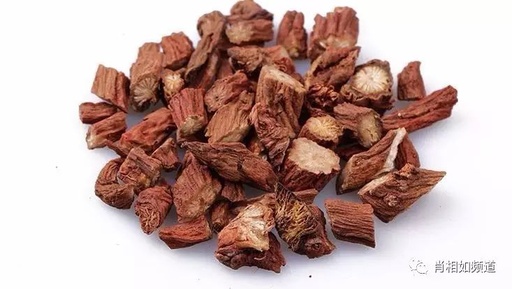Zhao Xiaofan notes:Dan Shen (Salvia miltiorrhiza), according to both the fifth and seventh editions of current TCM textbooks, is said to have a slightly cold nature, which is derived from the “Shen Nong’s Herbal Classic.” However, to trust the book blindly is worse than having no book at all. The discussions by Shou Yi are sharp and straightforward, and compared to Ling’s “Herbal Benefits and Harms,” they can be considered quite elegant. I record this here for the reference of various practitioners.
This article is excerpted from Zhang Shanlei’s “Herbal Justice.”
Dan Shen
“Shen Nong’s Herbal Classic”: Bitter and slightly cold in nature. It is indicated for evil qi in the heart and abdomen, with gurgling sounds in the intestines like flowing water, accumulation of cold and heat, breaking cysts and removing masses, alleviating fullness and benefiting qi.
“Bencao Bie Lu”: Nourishes blood, removes stubborn diseases and qi stagnation in the heart and abdomen, strengthens the waist and spine, alleviates leg numbness, and expels wind evil and residual heat.
【Justice】
Dan Shen is red in color and primarily targets the blood aspect. It is bitter and slightly pungent. The “Shen Nong’s Herbal Classic” describes it as slightly cold, but Tao Hongjing has doubted this, and Miao Zhongchun also questioned it. It was Zhang Shiwang who changed it to slightly warm. A detailed examination of the indications in the “Shen Nong’s Herbal Classic” and “Bencao Bie Lu” supports Shiwang’s view.
The evil qi in the heart and abdomen, gurgling sounds in the intestines, and stubborn diseases with qi stagnation are all due to the failure of clear yang to express, resulting in a deficiency of cold qi stagnation. Dan Shen promotes the circulation of blood stagnation and nourishes the qi mechanism, which is why it is indicated.
Accumulation of cold and heat leading to cysts and masses are also symptoms of qi stagnation and blood stasis, without warming and promoting qi and blood, how can they dissipate?
To alleviate fullness and vexation, qi movement follows blood, thus it can remove vexation and fullness. Moreover, the bitterness of the herb is primarily for descending and dispersing.
“Bencao Bie Lu” indicates it for strengthening the waist and spine, alleviating leg numbness, also for warming and promoting qi and blood, hence it can open the channels and relieve numbness.
To expel wind evil and residual heat, the wind invades the exterior, becomes stagnant and turns into heat, thus it is dispersed with a warm and gentle qi. Moreover, ancient practitioners often used warming herbs to treat wind, unlike the current practices in the southeastern regions where wind-heat diseases are treated with cool pungent herbs.
【Correcting Errors】
Both the “Shen Nong’s Herbal Classic” and “Bencao Bie Lu” state that Dan Shen is slightly cold, yet its indications for evil qi in the heart and abdomen, gurgling sounds in the intestines, and stubborn diseases with qi stagnation are all due to cold evil as the disease, thus it should not be treated with cold herbs. As for the accumulation of cysts and masses, it is also not a matter of warming and promoting.
In the past, Tao Yinjian stated that long-term use leads to red eyes, indicating its nature should be warm.Now, considering its red color and blood circulation, it is certainly not a slightly cold substance, thus Shiwang’s change to slightly warm is not arbitrary.
Even when referring to “Bencao Bie Lu” regarding strengthening the waist and alleviating leg numbness, and Tao Hongjing’s treatment of wind-dampness causing leg weakness, and the “Sheng Hui Fang” indicating it for cold hernia, all clinical applications are credible, thus the error regarding its cold nature is beyond doubt.
However, Zhang Yinan, Ye Tianshi, and others, who particularly adhere to the “Shen Nong’s Herbal Classic,” have overly adhered to it, leading to confusion in the full text of indications, thus being overly rigid, which does not truly elucidate the profound meanings.
One
“Rihua Bencao” records the indications of Dan Shen most comprehensively, yet also most chaotically. It mentions bone and joint pain, limbs not moving, which aligns with the “Bencao Bie Lu” symptoms of strengthening the spine and alleviating leg numbness.
It even states it is indicated for headaches and red eyes, which contradicts Tao Hongjing’s statement about long-term use leading to red eyes, and also mentions treating cold and heat fatigue, heat-induced mania, breaking old blood and generating new blood, calming pregnancy, expelling dead fetus, stopping bleeding, regulating women’s menstrual irregularities, treating sores and skin diseases, goiter, dan poison, expelling pus and relieving pain, promoting muscle and flesh growth, etc., which are all disorganized and fabricated.
Although such baseless claims are not worth debating, it is indeed unfortunate that recent popular books have adopted such nonsense, misleading scholars, which is quite numerous. Moreover, practitioners like Jingyue, Shicai, and Shiwang have also cited them without discernment, so how can we blame Wang Qie’an and Wu Yiluo for their blind following?
Examining the “Rihua,” it is entirely a compilation and not based on true knowledge and insight to elucidate medical principles, and it is similar to Wang’s “Jijie” and Wu’s “Congxin,” which are not worth discussing.
Two
It is a pity that Li Binhuh is most renowned for his erudition, and cannot be compared to mere copyists. However, the “Bencao Gangmu” also seeks to be comprehensive, not knowing how to be selective, which instead misleads future generations, leading them into darkness.
Moreover, the herbal texts after the Ming dynasty often follow Li’s teachings, casually excerpting a few sentences, thus forming a school, leading the blind to guide the blind into the fire pit.
Binhuh also cites a formula called Dan Shen San from the “Ming Theory,” claiming it has the same effect as the Si Wu Tang, stating it treats women’s menstrual irregularities, whether early or late, excessive or insufficient, pre-labor discomfort, and postpartum blood not flowing, along with treating cold and heat fatigue, which is directly echoing the claims of Rihua.
In summary, the Si Wu formula is already a blind man’s talk of treating women, and to further create another formula is indeed a great joke. How can there be a principle of treating all diseases with one herb or one formula without considering cold, heat, deficiency, or excess? The authorship of such texts is unknown, yet they are given a prestigious name, calling it “Ming Theory,” which is truly a contradiction of name and reality.
Three
Since Li’s collection, later generations have all copied it, and common people prefer its simplicity and ease of use, memorizing it and misusing it, which is why medicine cannot be questioned again, and it is the fault of the author for not knowing how to edit and refine.
Nowadays, people often use Dan Shen to treat coughing blood and hemoptysis, likely taking it for its qi descending properties. It primarily targets the blood aspect, who would dare say it is not?
However, the reason for its ineffectiveness is that bitterness descending must harm the middle qi, and warming and promoting does not stop bleeding; each time it worsens the cough, and the bitterness obstructs the middle, leading to spleen damage, thus creating a separate pathway for disease beyond the usual.
“Sheng Hui Fang” treats cold hernia, with pain in the lower abdomen, sweating, and a desire to die, using it as a powder, taken with hot wine. Ye Tianshi’s “Bencao Notes” also records it, but changes it to treat damp-heat hernia, thus mistakenly believing in the cold nature of Dan Shen from the “Shen Nong’s Herbal Classic.” However, this is in stark contradiction to the original intention of the “Sheng Hui.”
The women’s “Ming Theory” Dan Shen San is precisely this formula, intending to treat all women’s cold, heat, deficiency, and excess diseases, which can be considered extremely absurd, thus being a thief of medicine.
You may also like, click to read the original text:
Is licorice really optional?
Does gypsum need to be pre-boiled?
Febrile Diseases | The Division of Yin and Yang Between Movement and Stillness – Gan Lan Water
Enter the main menu and click Published Selections to see morearticles on “Kidney Disease and Kidney Deficiency,” “Dual Nature,” “Febrile Diseases,” “Medical Cases,” and discussions on TCM.
Health | Happiness | Freedom
Xiao Xiangru Channel Long press the QR code to recognize and follow
Long press the QR code to recognize and follow
Welcome everyone to leave comments for discussion
Submissions can be sent to: [email protected]
Search on Sina: Traditional Chinese Medicine Xiao Xiangru

